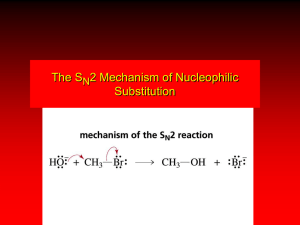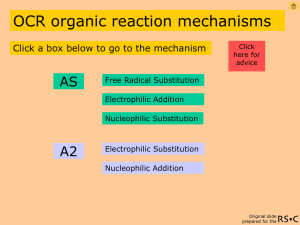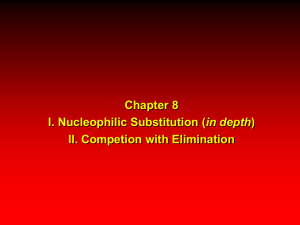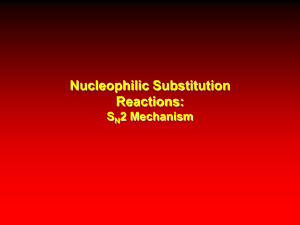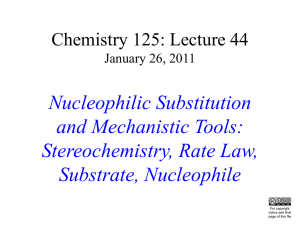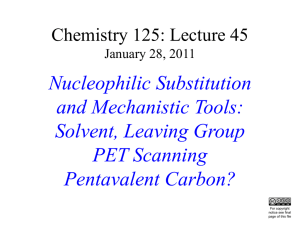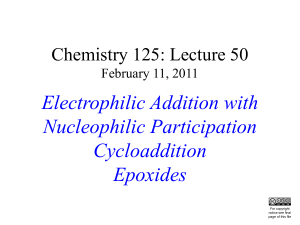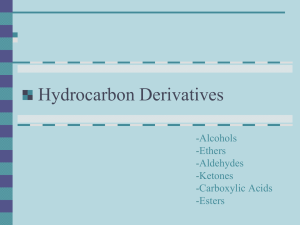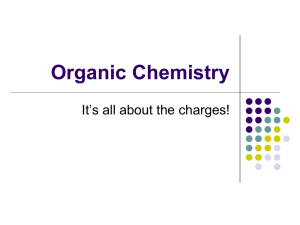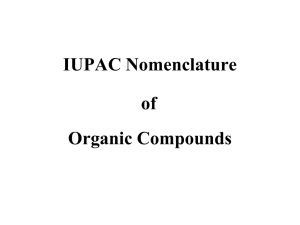SN2 Reaction Mechanism: Nucleophilic Substitution
advertisement
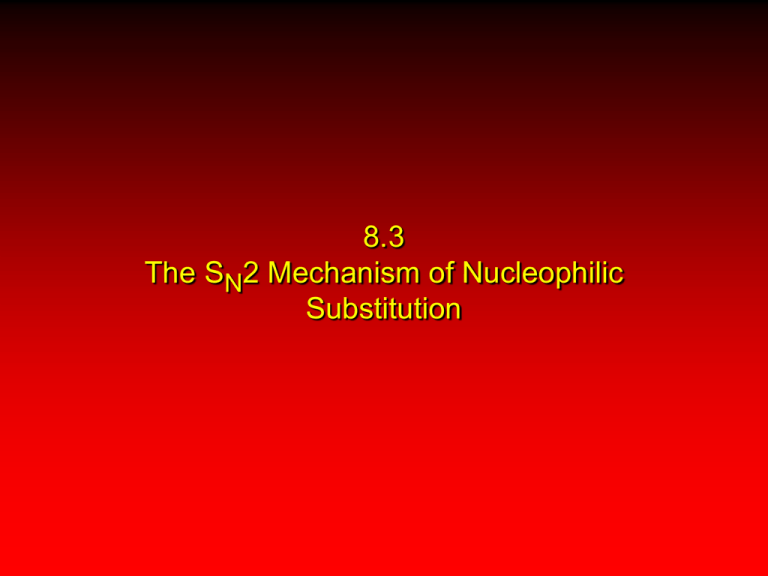
8.3 The SN2 Mechanism of Nucleophilic Substitution Kinetics Many nucleophilic substitutions follow a second-order rate law. CH3Br + HO – CH3OH + Br – rate = k[CH3Br][HO – ] inference: rate-determining step is bimolecular Bimolecular mechanism one step concerted HO – + CH3Br HOCH3 + Br – Bimolecular mechanism one step concerted HO – + CH3Br HOCH3 + Br – Bimolecular mechanism dHO dBr CH3 transition state one step concerted HO – + CH3Br HOCH3 + Br – 8.4 Stereochemistry of SN2 Reactions Generalization Nucleophilic substitutions that exhibit second-order kinetic behavior are stereospecific and proceed with inversion of configuration. Inversion of Configuration nucleophile attacks carbon from side opposite bond to the leaving group Inversion of Configuration nucleophile attacks carbon from side opposite bond to the leaving group three-dimensional arrangement of bonds in product is opposite to that of reactant Stereospecific Reaction A stereospecific reaction is one in which stereoisomeric starting materials give stereoisomeric products. The reaction of 2-bromooctane with NaOH (in ethanol-water) is stereospecific. (+)-2-Bromooctane (–)-2-Octanol (–)-2-Bromooctane (+)-2-Octanol Stereospecific Reaction H (CH2)5CH3 CH3(CH2)5 H NaOH C Br CH3 (S)-(+)-2-Bromooctane HO C CH3 (R)-(–)-2-Octanol Problem 8.4 The Fischer projection formula for (+)-2-bromooctane is shown. Write the Fischer projection of the (–)-2-octanol formed from it by nucleophilic substitution with inversion of configuration. Problem 8.4 The Fischer projection formula for (+)-2-bromooctane is shown. Write the Fischer projection of the (–)-2-octanol formed from it by nucleophilic substitution with inversion of configuration. CH3 H CH3 Br CH2(CH2)4CH3 HO H CH2(CH2)4CH3 8.5 How SN2 Reactions Occur CH3(CH2)5 H –.. C HO .. H3C .. Br .. : CH3(CH2)5 d.. – HO .. H C CH3 CH3(CH2)5 H –.. C HO .. H3C .. Br .. : .. d – Br .. : CH3(CH2)5 d.. – HO .. H .. d – Br .. : C CH3 CH3(CH2)5 H –.. C HO .. H3C .. Br .. : .. HO .. H (CH ) CH 2 5 3 .. – C Br .. : CH3 8.6 Steric Effects in SN2 Reactions Crowding at the Reaction Site The rate of nucleophilic substitution by the SN2 mechanism is governed by steric effects. Crowding at the carbon that bears the leaving group slows the rate of bimolecular nucleophilic substitution. Table 8.2 Reactivity toward substitution by the SN2 mechanism RBr + LiI RI + LiBr Alkyl bromide Class Relative rate CH3Br Methyl 221,000 CH3CH2Br Primary 1,350 (CH3)2CHBr Secondary 1 (CH3)3CBr Tertiary too small to measure Decreasing SN2 Reactivity CH3Br CH3CH2Br (CH3)2CHBr (CH3)3CBr Decreasing SN2 Reactivity CH3Br CH3CH2Br (CH3)2CHBr (CH3)3CBr Crowding Adjacent to the Reaction Site The rate of nucleophilic substitution by the SN2 mechanism is governed by steric effects. Crowding at the carbon adjacent to the one that bears the leaving group also slows the rate of bimolecular nucleophilic substitution, but the effect is smaller. Table 8.3 Effect of chain branching on rate of SN2 substitution RBr + LiI RI + LiBr Alkyl bromide Structure Relative rate Ethyl CH3CH2Br 1.0 Propyl CH3CH2CH2Br 0.8 Isobutyl (CH3)2CHCH2Br 0.036 Neopentyl (CH3)3CCH2Br 0.00002
